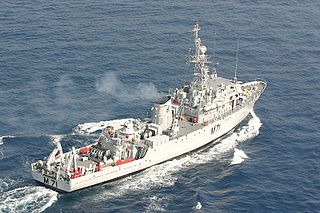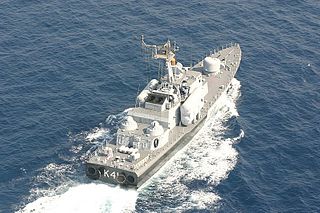
The Oliver Hazard Perry class is a class of guided-missile frigates named after the U.S. Commodore Oliver Hazard Perry, the hero of the naval Battle of Lake Erie. Also known as the Perry or FFG-7 class, the warships were designed in the United States in the mid-1970s as general-purpose escort vessels inexpensive enough to be bought in large numbers to replace World War II-era destroyers and complement 1960s-era Knox-class frigates. In Admiral Elmo Zumwalt's "high low fleet plan", the FFG-7s were the low capability ships with the Spruance-class destroyers serving as the high capability ships. Intended to protect amphibious landing forces, supply and replenishment groups, and merchant convoys from aircraft and submarines. They were also later part of battleship-centred surface action groups and aircraft carrier battle groups/strike groups. Fifty-five ships were built in the United States: 51 for the United States Navy and four for the Royal Australian Navy (RAN). In addition, eight were built in Taiwan, six in Spain, and two in Australia for their navies. Former U.S. Navy warships of this class have been sold or donated to the navies of Bahrain, Egypt, Poland, Pakistan, Taiwan, and Turkey.

The Centaur class of aircraft carriers of the Royal Navy was the last of the light fleet carrier designs started during the closing years of World War II. The first ship of the original four in the class was commissioned in 1953 and the final decommissioned in 1984. The first three ships lacked an angled flight deck and were therefore unsuitable for fast jet aircraft, and production of a second batch of four carriers was cancelled.

The Belgian Navy, officially the Belgian Naval Component of the Belgian Armed Forces, is the naval service of Belgium.

The Pondicherry class are a class of minesweepers built for the Indian Navy by the Soviet Union. They are modified versions of the Natya-class minesweeper. The vessels were acquired in two batches. The first were purchased from 1977 to 1980 and the second from 1986 to 1988. Technically, the second batch is referred to as the Karwar class but are physically identical to the first batch with the exception of additional surface-to-air missiles. As minesweepers, they are large and heavily armed. They can serve a dual purpose as an anti-submarine warfare escort. Their hulls are constructed of U3 low magnetic signature steel.

The Veer-class corvettes of the Indian Navy are a customised Indian variant of the Soviet Tarantul class. They form the 22nd Killer Missile Vessel Squadron.
USS LST-973 was an LST-542-class tank landing ship in the United States Navy. Like many of her class, she was not named and is properly referred to by her hull designation.




